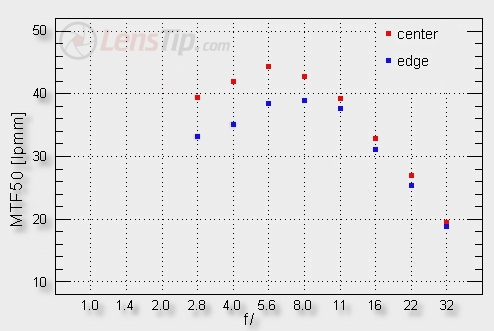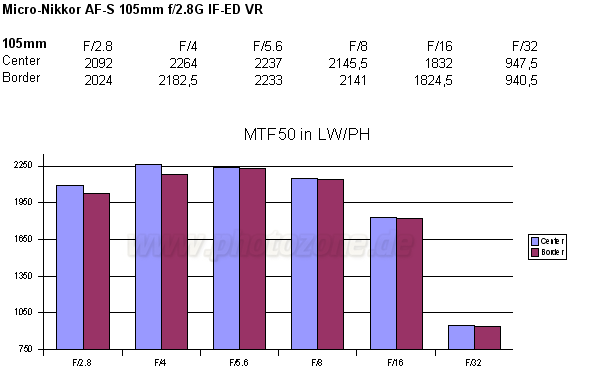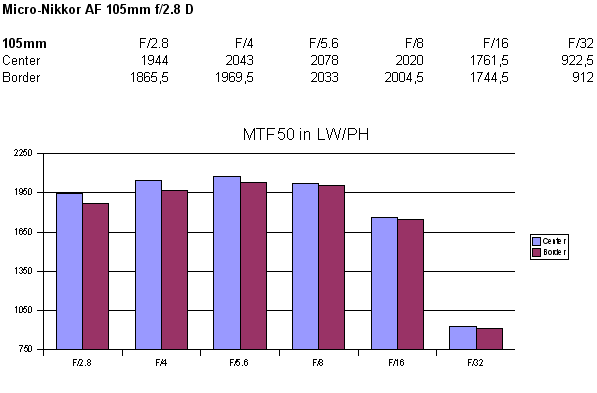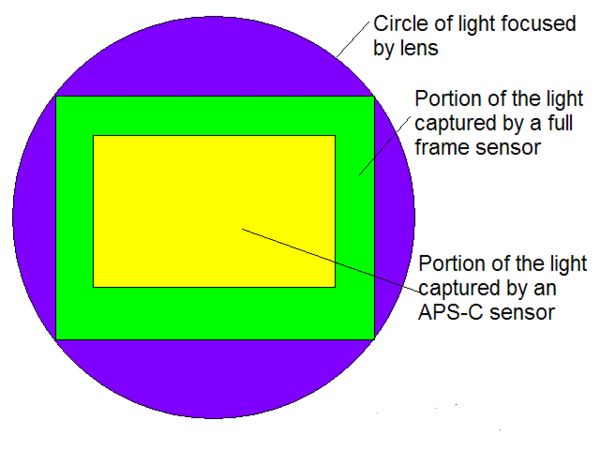"Sweet Spot" vs Maximum DOF for the Nikkor 105 macro lens
Mar 23, 2012 13:25:09 #
For Sarge, and other inquiring minds:
Each and every lens has a "Sweet Spot": an aperture setting where resolution (sharpness) is paramount. This is usually mid-range of aperture choices. Lab testing provides a chart for easy viewing of relative resolutions at different apertures (below).
That being stated, mid-range aperture is not conducive for maximum Depth-of-Field (DOF). At Minimum Working Distance (MWD) to achieve 1:1 magnification (life-size on sensor), DOF is measured in millimeters. To hold even a small spider in focus, an aperture of f/22 or even f/32 is sometimes required.
I previously worked with a Nikkor 105D, and currently work with a Nikkor 105G. MFD is about 6-inches, but I prefer about 9-inches to 12-inches (for better DOF), then crop final image. At ISO 400, and with channeled speedlight illumination, my aperture of choice is f/22. I will open to f/16 for dark subjects, and reduce speedlight output for light-colored subjects.
Macro-Photography is a science of compromise. The trick is to capture the majority of your subject in focus, with acceptable resolution.
Each and every lens has a "Sweet Spot": an aperture setting where resolution (sharpness) is paramount. This is usually mid-range of aperture choices. Lab testing provides a chart for easy viewing of relative resolutions at different apertures (below).
That being stated, mid-range aperture is not conducive for maximum Depth-of-Field (DOF). At Minimum Working Distance (MWD) to achieve 1:1 magnification (life-size on sensor), DOF is measured in millimeters. To hold even a small spider in focus, an aperture of f/22 or even f/32 is sometimes required.
I previously worked with a Nikkor 105D, and currently work with a Nikkor 105G. MFD is about 6-inches, but I prefer about 9-inches to 12-inches (for better DOF), then crop final image. At ISO 400, and with channeled speedlight illumination, my aperture of choice is f/22. I will open to f/16 for dark subjects, and reduce speedlight output for light-colored subjects.
Macro-Photography is a science of compromise. The trick is to capture the majority of your subject in focus, with acceptable resolution.
Nikkor 105G Resolution chart

MTF (Resolution) for Nikkor AF 105mm 2.8 G

MTF (Resolution) for Nikkor AF 105mm 2.8 D

Mar 24, 2012 09:49:49 #
Just to be sure I understand the charts: if you stop down the lens and crop the image, e.g. by half both vertically and horizontally, ans then enlarge the chosen section, you will indeed have greater depth of field but you will have cut resolution by half. On the first chart for the 105G, going from f/5.6 to f/22 cuts the resolution by about half, and then such cropping cuts it by half again, right? But you always get such detailed photos, would it be fair to say that depth of field generally trumps tested resolution, at least for this lens and other macro lenses? if so, would it be defensible to buy a less expensive macro lens that stops down to f/32 rather than a more expensive lens that only goes to f/16 or f/22, even if the more expensive lens touts higher resolution?
Mar 24, 2012 11:56:29 #
Mar 24, 2012 13:07:55 #
Roy Hakala wrote:
I have no idea. Higher priced lenses are usually larger glass, increasing aperture on other end of scale, i.e. f/2.8 vs f/3.5. It is easy to make a lens close-down to f/32; it is difficult (and expensive) to make glass big enough to allow f/2.8.Would it be defensible to buy a less expensive macro lens that stops down to f/32 rather than a more expensive lens that only goes to f/16 or f/22, even if the more expensive lens touts higher resolution?
Mar 24, 2012 13:35:11 #
Nikonian72 wrote:
I am also curious whether you personally have compared crop sensor cameras to full sensors when doing macro. Smaller sensors produce a greater depth of field at the same field of view. Do you find a full size sensor an advantage or disadvantage for the kind of macro that you do?Roy Hakala wrote:
I have no idea. Higher priced lenses are usually larger glass, increasing aperture on other end of scale, i.e. f/2.8 vs f/3.5. It is easy to make a lens close-down to f/32; it is difficult (and expensive) to make glass big enough to allow f/2.8.Would it be defensible to buy a less expensive macro lens that stops down to f/32 rather than a more expensive lens that only goes to f/16 or f/22, even if the more expensive lens touts higher resolution?
Mar 24, 2012 13:58:40 #
Roy Hakala wrote:
In the past, I have used a Nikkor 105-mm macro lens on film cameras (same size as FX sensor). There is absolutely no difference in DOF when using same lens on either a DX or an FX sensor.I am also curious whether you personally have compared crop sensor cameras to full sensors when doing macro. Smaller sensors produce a greater depth of field at the same field of view. Do you find a full size sensor an advantage or disadvantage for the kind of macro that you do?
The two main differences:
1.) added peripheral area captured by an FX sensor that is not seen by a DX sensor, with same lens, at same WD;
2.) 1:1 capture with DX sensor at MFD, vs extension tube needed to capture 1:1 on FX sensor.
FX vs DX Field Comparison

Mar 24, 2012 14:04:01 #
Roy Hakala wrote:
Cropping 1/2 vertically & 1/2 horizontally = 1/2 x 1/2 = 1/4 of original pixel count = 4x enlargement of original subject captured.if you stop down the lens and crop the image, e.g. by half both vertically and horizontally, ans then enlarge the chosen section, you will indeed have greater depth of field but you will have cut resolution by half.
Mar 25, 2012 15:18:10 #
I guess I wasn't clear on the field of view thing. I understand that a single lens produces the same depth of field no mater what sensor is behind it, but I had a different comparison in mind. A 105 mm lens produces a certain field of view on an FX sensor. A 70 mm lens produces approximately the same field of view on a DX sensor. I would expect the 70 mm to produce greater depth of field, and I wondered if you found that significant in macro work.
Also, I guess I am confused on the definition of 2X. I thought that cropping by half each way and enlarging to the original size of the frame produced a subject image that is twice as tall as the original, and therefore would be a 2x image. I understand that cropping half each way leaves only 1/4 of the original pixels and produces an object's image that is twice as high and twice as wide as the original. Does that make it a 4x image?
Also, I guess I am confused on the definition of 2X. I thought that cropping by half each way and enlarging to the original size of the frame produced a subject image that is twice as tall as the original, and therefore would be a 2x image. I understand that cropping half each way leaves only 1/4 of the original pixels and produces an object's image that is twice as high and twice as wide as the original. Does that make it a 4x image?
Mar 25, 2012 19:13:44 #
Roy Hakala wrote:
This is probably true, but I have no FX sensor camera, nor a 70-mm macro lens for comparative use.A 105 mm lens produces a certain field of view on an FX sensor. A 70 mm lens produces approximately the same field of view on a DX sensor. I would expect the 70 mm to produce greater depth of field, and I wondered if you found that significant in macro work.
Roy Hakala wrote:
Yes. As an example, let us imagine four miniature dominoes arranged 2x2, which fill our imaginary camera's FoV at 1:1 (life-size). If we use extension tubes so that only a single domino is viewed, we have reduces width by half, and height by half, now seeing 1/4 of original FoV, which equals 4:1 magnification (4x life-size). Post Process cropping of a captured image can provide the same result.Also, I guess I am confused on the definition of 2X. I thought that cropping by half each way and enlarging to the original size of the frame produced a subject image that is twice as tall as the original, and therefore would be a 2x image. I understand that cropping half each way leaves only 1/4 of the original pixels and produces an object's image that is twice as high and twice as wide as the original. Does that make it a 4x image?
Mar 25, 2012 23:56:35 #
If you want to reply, then register here. Registration is free and your account is created instantly, so you can post right away.

